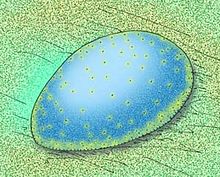| Solza Temporal range: Ediacaran, around 555 Ma PreꞒ Ꞓ O S D C P T J K Pg N ↓ | |
|---|---|

| |
| S. margarita | |
| Scientific classification | |
| Kingdom: | Animalia |
| (unranked): | Bilateria |
| Genus: | †Solza Ivantsov, 2004 |
| Type species | |
| †Solza margarita Ivantsov, 2004 | |
| Species | |
| |
Solza margarita is an extinct animal of uncertain phylogeny which lived about 555 mya in the Ediacaran period.
Occurrence
Fossils of the Solza margarita is found in the Verkhovka and Zimnegory formations on the Solza River and Zimnii Bereg (Winter Coast), White Sea area of the Arkhangelsk Region, Russia.
Etymology
The generic name Solza comes from the Solza river on the Onega Peninsula, White Sea, where the holotype and first specimens were found. The specific name, margarita, derives from the Greek μαργαριτηζ (margarita), meaning "pearl".
Description
Solza was the shape of a low oblique cone with a base, which is egg-like in cross-section. Fossil impressions are covered by the meshwork of grooves, which is wide at the apex of the cone, narrowing and diverging towards the animal's edges.
In the first description it was suggested that the grooves were formed postmortem above cavities inside the body or they covered the body surface during the animal’s life.
- In the first view the grooves were interpreted as internal tubes in the living Solza, and opened to narrow pores along its surface. It was suggested that the canals hypothetically could be associated with feeding and represented system for filtering a suspension and microorganisms from water.
- According to the second view, the grooves are relief texture of the body surface during the animal’s life, resembling the non-mineralized patelliform shell, similar to the ones seen on Kimberella. Exactly this view was accepted in recent studies.
Described specimens of Solza range from 7.2–10.5mm in length, and 5.3–8mm wide. Most specimens show slight distortion, but preserve the basic egg-shape, implying that Solza had at least some firmness.
Behavior
Fossil specimens easily demonstrate that Solza was a benthic, bilaterally symmetric organism: thus, it was likely a motile, mobile animal that adhered to the substrate.
See also
References
- ^ Ivantsov, A. Yu. (2012). "Paleontological Data on the Possibility of Precambrian Existence of Mollusks". In Averkii Fyodorov; Havrila Yakovlev (eds.). Mollusks: Morphology, Behavior and Ecology. Nova Science Pub Incorporated. pp. 153–179. ISBN 9781621009870.
- Paleontological Journal. Pleiades Publishing Ltd.
- ^ Ivantsov, A.Y.; Malakhovskaya, Y.E.; Serezhnikova, E.A. (2004). "Some Problematic Fossils from the Vendian of the Southeastern White Sea Region" (PDF). Paleontological Journal. 38 (1): 1–9. Archived from the original (PDF) on 2007-07-04.
- ^ Andrey Yu. Ivantsov (2010). "Paleontological evidence for the supposed precambrian occurrence of mollusks". Paleontological Journal. 40 (12): 1552–1559. Bibcode:2010PalJ...44.1552I. doi:10.1134/S0031030110120105. S2CID 86523806.
- ^ Ivantsov, A. Yu.; Leonov M. V. (2009). The imprints of Vendian animals - unique paleontological objects of the Arkhangelsk region (in Russian). Arkhangelsk. p. 91. ISBN 978-5-903625-04-8.
{{cite book}}: CS1 maint: location missing publisher (link)
| Taxon identifiers | |
|---|---|
| Solza | |
Categories: